Finding the perfect hairstyle for your child can feel overwhelming, especially when you want something that’s both stylish and manageable.
If you’re exploring protective styling options or embracing natural hair textures, 37 Adorable Dreadlock Styles for Kids That Are Easy & Cute offers a comprehensive guide to beautiful, low-maintenance looks that children absolutely love.
Dreadlocks aren’t just a hairstyle—they’re a celebration of culture, individuality, and natural beauty that can boost your child’s confidence while keeping their hair healthy and protected.
Whether your little one has fine, thick, curly, or coily hair, this article showcases versatile dreadlock styles ranging from playful ponytails to elegant updos, complete with styling tips, maintenance advice, and creative variations.
From toddlers taking their first steps into protective styling to pre-teens wanting trendy looks for school, you’ll discover age-appropriate options that balance cuteness with practicality.
Each style is designed with busy parents in mind, offering easy-to-recreate looks that won’t consume your mornings or require professional salon visits every week.
Get ready to transform your child’s hair routine with these adorable dreadlock styles that prove protective hairstyles can be fun, fashionable, and incredibly cute.
Contents
- 1 1. Classic Short Dreads
- 2 2. Two-Strand Twist Starter Locs
- 3 3. High Ponytail Dreads
- 4 4. Half-Up Half-Down Style
- 5 5. Space Buns with Dreads
- 6 6. Side Swept Dreads
- 7 7. Top Knot Dreads
- 8 8. Braided Dreadlock Headband
- 9 9. Mohawk-Style Dreads
- 10 10. Zigzag Part Dreads
- 11 11. Pigtail Dreads
- 12 12. Crown Braid with Dreads
- 13 13. Bubble Ponytail Dreads
- 14 14. Faux Hawk Dreads
- 15 15. Low Bun Dreads
- 16 16. Twisted Crown Dreads
- 17 17. Side Braid Accent
- 18 18. Flower Crown Dreads
- 19 19. Rope Twist Ponytail
- 20 20. Multiple Mini Buns
- 21 21. Waterfall Dreads
- 22 22. Wrapped Ponytail Base
- 23 23. Asymmetrical Part Dreads
- 24 24. Beaded Dreads
- 25 25. Criss-Cross Base Ponytail
- 26 26. Side Part with Accessories
- 27 27. Barrel Roll Dreads
- 28 28. Triple Ponytail Cascade
- 29 29. Twisted Side Bu
- 30 30. Loc Mohawk with Curled Ends
- 31 31. Low Pigtails with Wrapped Bases
- 32 32. Heart-Shaped Part
- 33 33. Wrapped Ponytail Length
- 34 34. Bantu Knot-Out Dreads
- 35 35. Crown with Loose Cascade
- 36 36. Accessories-Filled Locs
- 37 37. Simple Middle Part with Loose Locs
- 38 Maintenance Tips for Kids’ Dreadlocks
- 39 Age-Appropriate Styling Considerations
- 40 Choosing the Right Style for Your Child
- 41 Product Recommendations for Kids’ Locs
- 42 Common Styling Mistakes to Avoid
- 43 Cultural Significance and Education
- 44 Dealing with School and Social Situations
- 45 Transitioning Between Styles
- 46 Long-Term Loc Care and Health
- 47 Conclusion
1. Classic Short Dreads
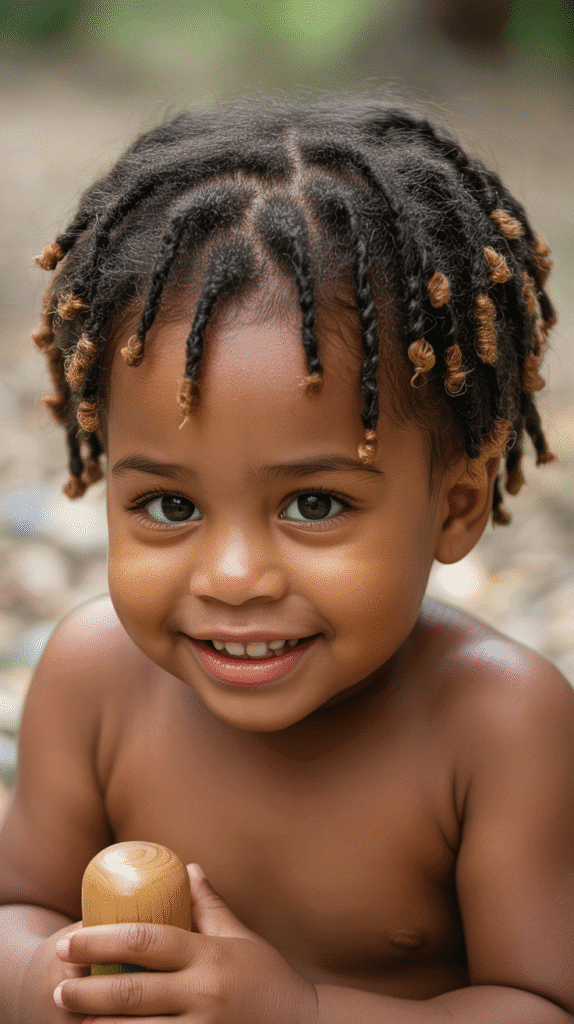
Classic short dreads offer the perfect starting point for kids new to the dreadlock journey, providing a neat, manageable length that works beautifully for active lifestyles.
This timeless style sits close to the scalp and typically extends just a few inches, making it ideal for toddlers and young children who are constantly on the move.
- Short dreads reduce tangling and matting issues that can occur with longer styles.
- This length requires minimal daily maintenance, usually just a simple moisturizing routine.
- The style works exceptionally well for fine hair textures that might struggle with heavier, longer locs.
- Parents appreciate how quickly short dreads dry after washing, preventing discomfort and potential scalp issues.
- The uniform length creates a polished appearance suitable for both casual play dates and formal occasions.
- Children can participate in all physical activities without hair getting in their face or causing distractions.
- Retwisting sessions are faster and less expensive compared to maintaining longer dreadlocks.
2. Two-Strand Twist Starter Locs
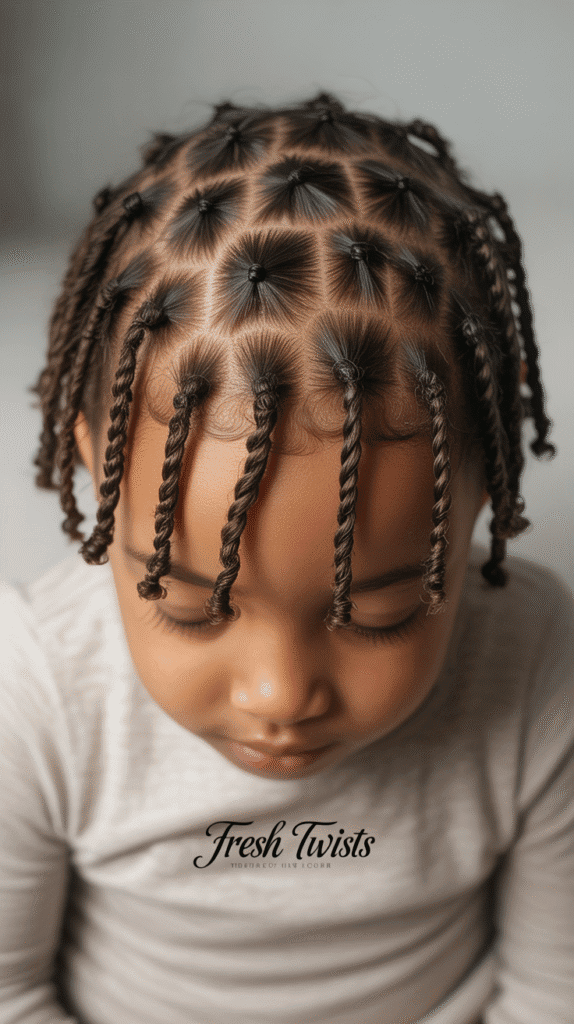
Two-strand twist starter locs provide a gentle introduction to dreadlocks while maintaining hair health during the locking process.
This method involves twisting two sections of hair around each other, creating defined spiral patterns that gradually mature into solid locs over time.
- The twisting technique causes less stress on young, developing hair follicles compared to other starting methods.
- This approach works beautifully on all hair textures, from loose curls to tight coils.
- Children experience less scalp tension during the installation process, making it more comfortable.
- The twists can be styled in various ways before they fully lock, offering versatility.
- Parents can easily learn to maintain and retwist these at home, saving salon costs.
- The method allows for gradual commitment, as twists can be unraveled if desired before full locking occurs.
- Two-strand twists create a rope-like texture that many children find visually appealing and fun.
3. High Ponytail Dreads
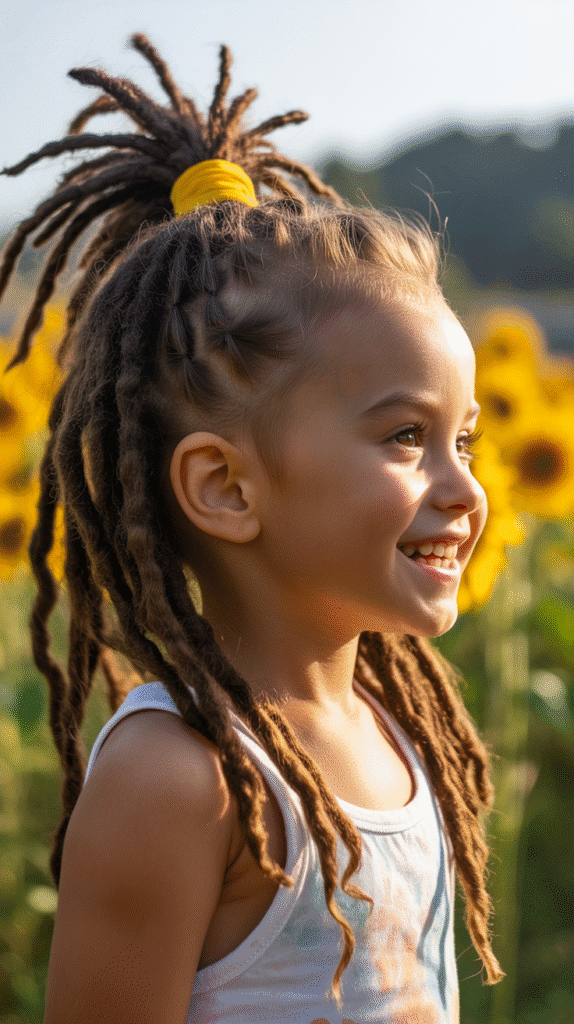
High ponytail dreads combine playful elevation with practical functionality, pulling locs away from the face in a style that’s both adorable and activity-friendly.
This updo works wonderfully for school days, sports, and special occasions when you want your child’s face to shine.
- The elevated position keeps hair completely off the neck, providing cooling comfort during hot weather.
- High ponytails showcase facial features beautifully, perfect for photo opportunities and special events.
- This style prevents locs from dragging on the ground during floor play or getting caught in backpacks.
- Children can easily wear helmets, hats, and headbands over a high ponytail without disruption.
- The tension distribution across the scalp is more balanced than side ponytails, reducing strain on specific areas.
- Adding colorful hair ties, ribbons, or beads creates instant personality and festive flair.
- The style takes just minutes to create in the morning, making it ideal for busy school routines.
4. Half-Up Half-Down Style
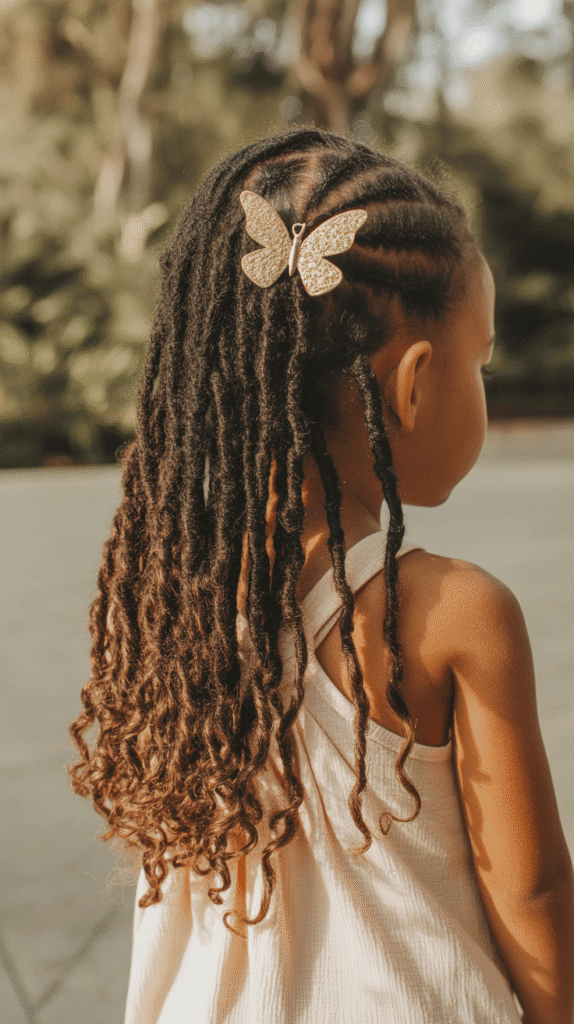
The half-up half-down style strikes the perfect balance between controlled and free-flowing, securing the top section while allowing the remaining locs to cascade naturally.
This versatile look adapts seamlessly from playground adventures to family gatherings.
- The top section stays secured away from eyes during reading, eating, and detailed activities.
- Bottom locs provide movement and visual interest that children love to show off.
- This style distributes weight evenly, preventing the discomfort that can come from pulling all hair into one point.
- Parents can customize the look by adjusting how much hair goes up versus down based on preferences.
- The separated sections make it easier to apply moisturizer to different areas of the scalp.
- Adding decorative clips or barrettes to the secured section creates personalized style statements.
- Children transitioning to updos find this style less restrictive and more comfortable initially.
5. Space Buns with Dreads
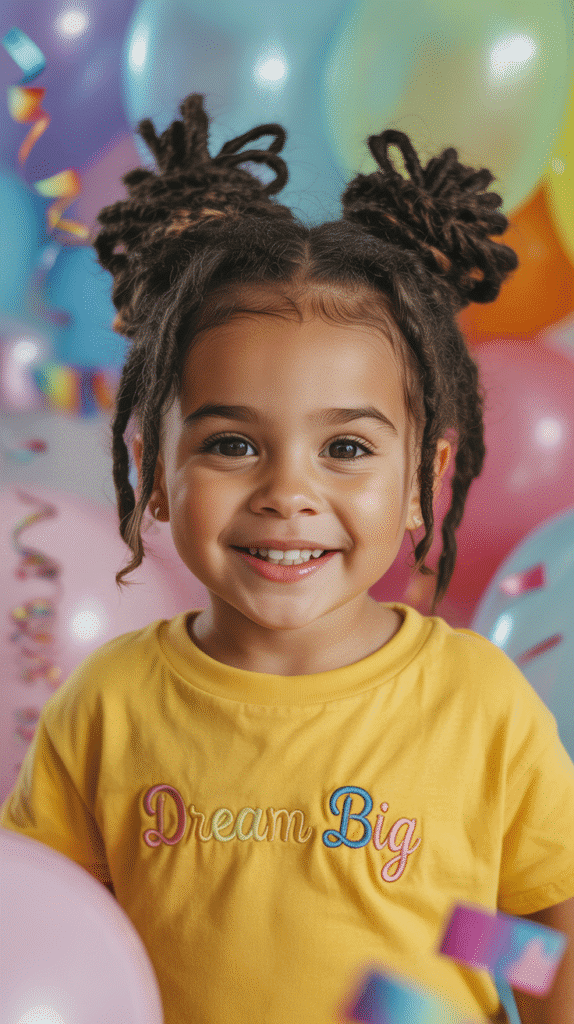
Space buns transform dreadlocks into playful, symmetrical buns positioned on either side of the head, creating an instantly recognizable and utterly adorable look.
This whimsical style has gained popularity for its fun factor and surprising practicality.
- The double-bun configuration keeps all hair secured and out of the way during active play.
- This style works particularly well for medium to long length locs that might otherwise feel heavy.
- Space buns create a balanced, symmetrical appearance that photographs beautifully.
- Children love the “Princess Leia” or cartoon character associations this style evokes.
- The buns can be positioned at various heights and tightness levels to suit comfort preferences.
- Accessorizing with bows, scrunchies, or glitter spray adds extra personality for special occasions.
- Despite looking complex, space buns are surprisingly quick to create once you master the technique.
6. Side Swept Dreads
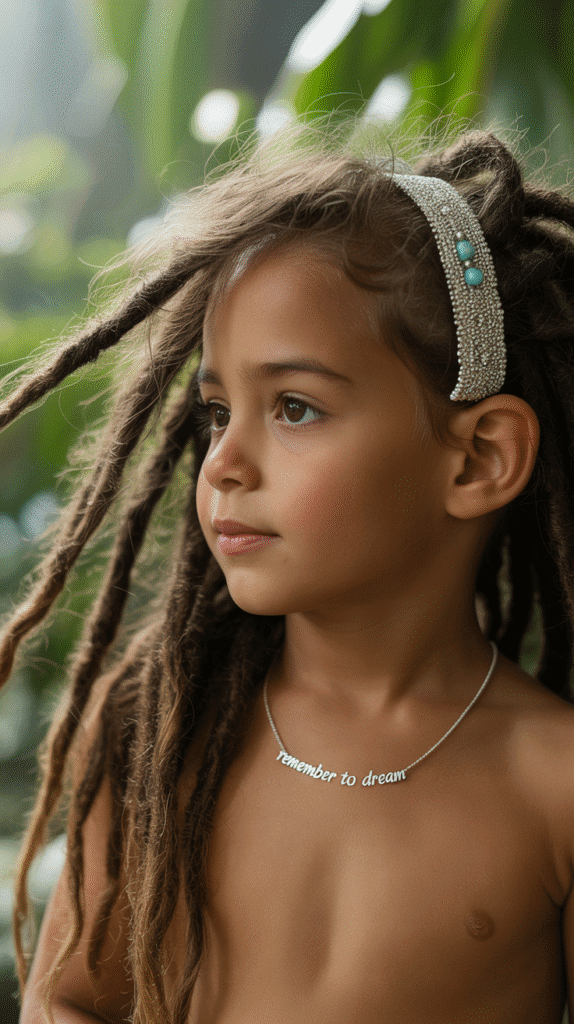
Side swept dreads create an elegant asymmetrical look by gathering all locs to one side of the head and shoulder.
This sophisticated yet simple style adds instant glamour while maintaining the protective benefits of secured hair.
- The side placement keeps hair away from one side of the face, useful for children who prefer one ear accessible.
- This style showcases the length and texture of locs beautifully as they drape over one shoulder.
- Side swept arrangements work wonderfully for formal events like weddings or holiday celebrations.
- Children who play musical instruments find this style accommodating for violin or other instruments.
- The weight distribution prevents the centered tension that some kids find uncomfortable.
- Adding a decorative pin or flower at the gathering point enhances the elegant aesthetic.
- This look transitions easily from day to evening by simply adjusting the securing method.
7. Top Knot Dreads
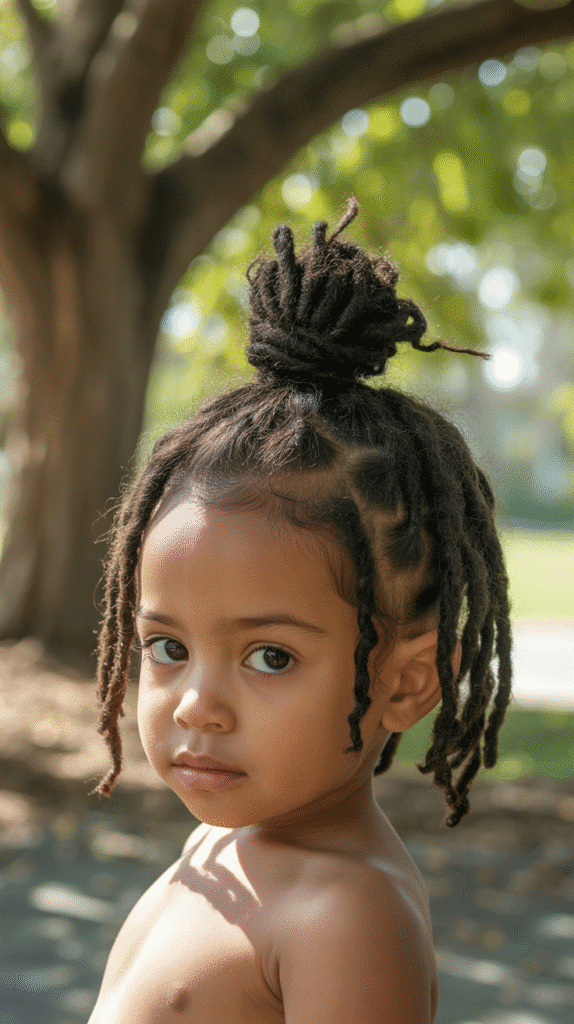
The top knot gathers dreadlocks into a single bun positioned at the crown of the head, creating a neat, elevated style that’s both practical and trendy.
This minimalist approach has become increasingly popular for its clean lines and effortless cool factor.
- Top knots provide maximum cooling by lifting all hair away from the neck and shoulders.
- The elevated position makes this style ideal for swimming, as hair stays mostly dry and manageable.
- Children appreciate how secure this style feels during running, jumping, and sports activities.
- The centered positioning distributes weight evenly, reducing strain on any particular area.
- This look requires minimal accessories—often just a single elastic band—making it budget-friendly.
- Top knots work well with various loc lengths, from shoulder-length to waist-length.
- The style highlights facial features and allows earrings or other accessories to shine.
8. Braided Dreadlock Headband
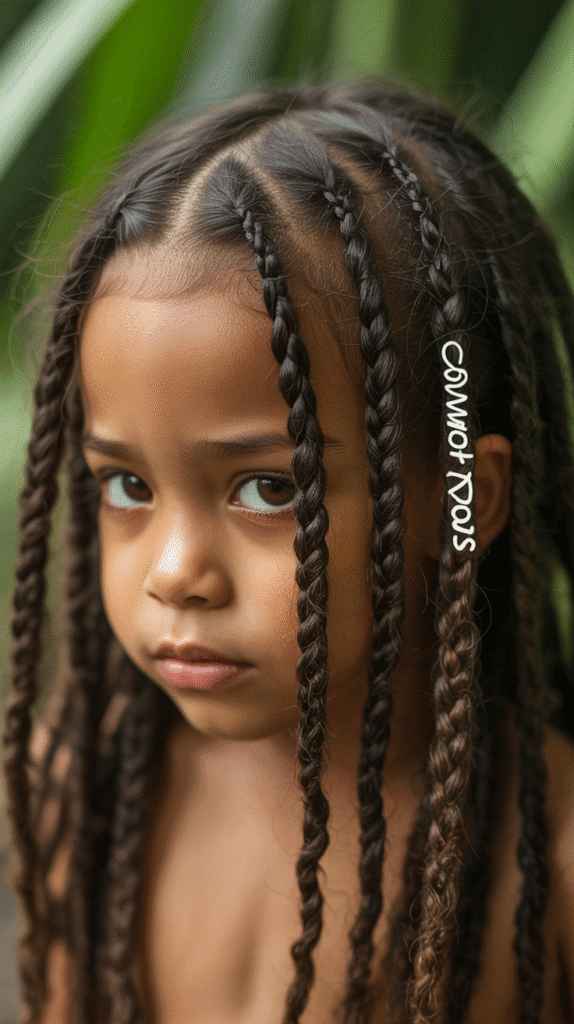
The braided dreadlock headband style incorporates a few locs braided along the hairline to create a natural headband effect while the remaining dreads flow freely.
This creative approach adds texture and visual interest to otherwise simple loose locs.
- The braided section frames the face beautifully, drawing attention to facial features.
- This style keeps front locs from falling into eyes during activities and homework.
- Children can participate in creating the braided headband, building hair care skills.
- The technique works with any loc length and thickness for versatile applications.
- Adding small beads or colored thread to the braided section creates customized patterns.
- The headband effect eliminates the need for actual headbands that can cause discomfort.
- This style transitions seamlessly from school to after-school activities without adjustment.
9. Mohawk-Style Dreads
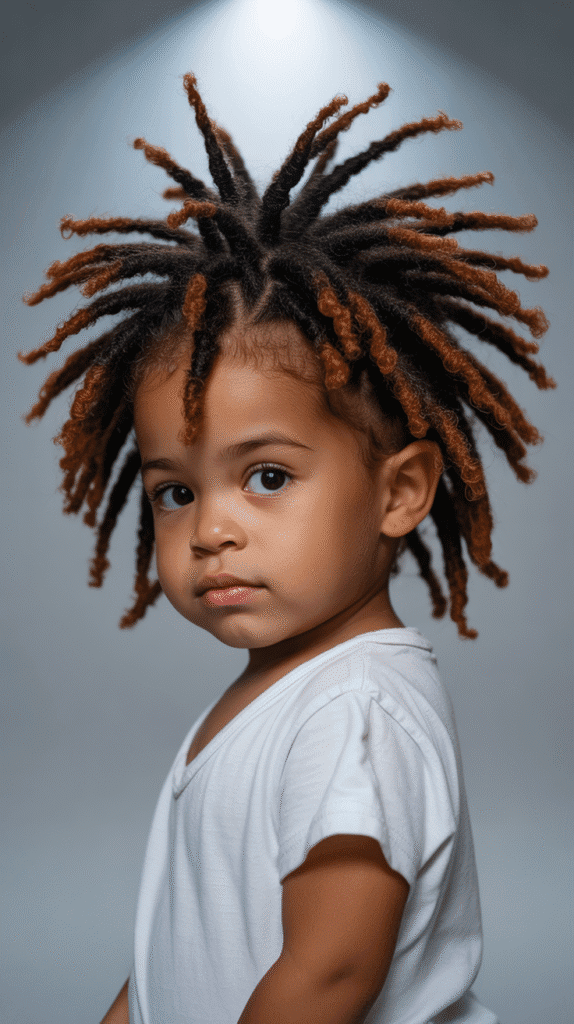
Mohawk-style dreads create a bold statement by gathering locs down the center of the head while keeping the sides sleek and close.
This edgy interpretation of classic dreadlocks brings attitude and personality to children’s protective styling.
- The centered strip of elevated locs creates dramatic visual impact perfect for confident kids.
- This style allows for creative height variations from subtle to extremely pronounced.
- The sleek sides reduce overall bulk while maintaining the protective benefits of locs.
- Children who love standing out appreciate the distinctive, fashion-forward appearance.
- The mohawk configuration actually reduces daily maintenance time compared to completely loose locs.
- Parents can adjust the width of the center section to create different intensity levels.
- This style works particularly well for special events, performances, or photo sessions.
10. Zigzag Part Dreads
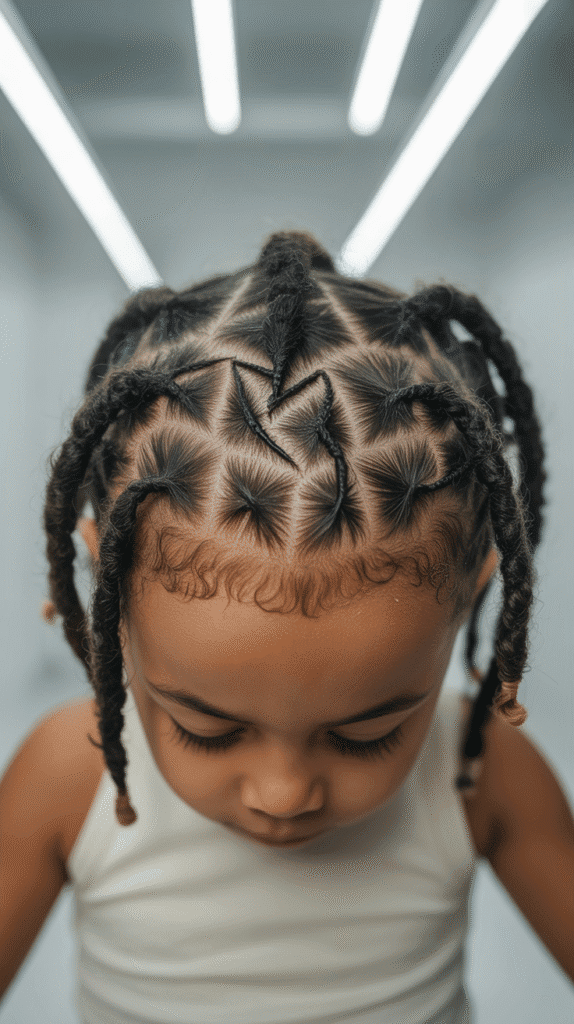
Zigzag part dreads replace traditional straight parts with playful zigzag patterns, adding geometric interest and personality to any dreadlock style.
This creative parting technique transforms simple looks into eye-catching designs.
- Zigzag parts create visual texture that makes even basic styles appear more elaborate.
- The varied angles help distribute scalp tension more evenly than straight parts.
- Children enjoy the fun, playful appearance that sets their style apart from peers.
- This parting technique works with any subsequent styling—ponytails, buns, or loose locs.
- Parents can create various zigzag patterns from subtle waves to dramatic sharp angles.
- The geometric patterns photograph beautifully, creating memorable images for milestones.
- Zigzag parts grow out less obviously than straight parts, extending style longevity.
11. Pigtail Dreads
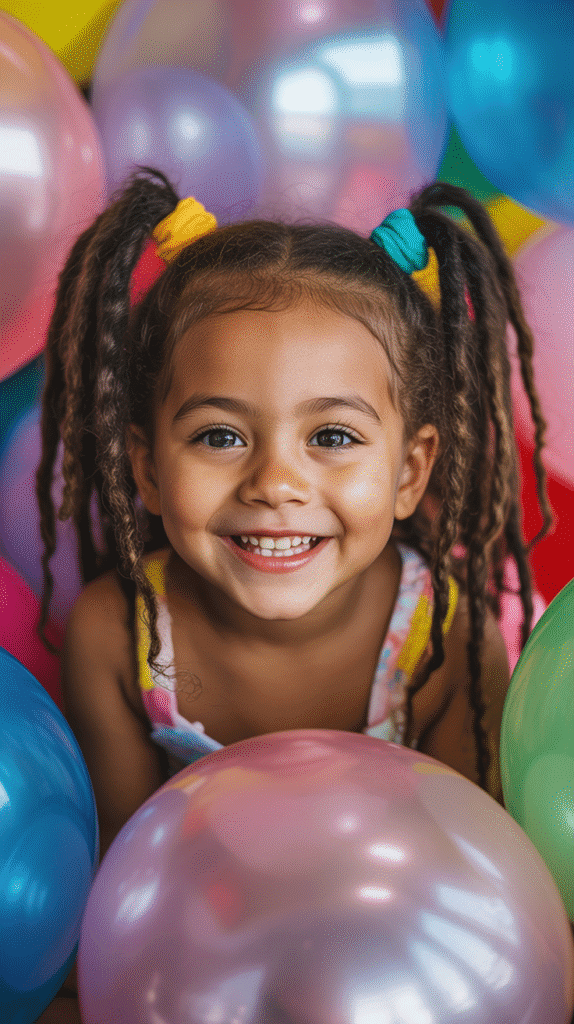
Pigtail dreads divide locs into two equal sections gathered on opposite sides of the head, creating a classic, youthful look that never goes out of style.
This timeless arrangement combines nostalgia with practical functionality.
- The symmetrical division creates balanced weight distribution that’s comfortable for all-day wear.
- Pigtails allow children to flip their locs playfully, adding to their enjoyment of the style.
- This arrangement keeps hair completely away from the face for unobstructed vision during activities.
- The two-section design makes detangling and maintenance more manageable by working with smaller portions.
- Pigtails can be positioned at various heights from low and relaxed to high and bouncy.
- Adding matching ribbons, scrunchies, or beads creates coordinated, adorable aesthetics.
- This style works beautifully for toddlers through pre-teens, making it truly age-versatile.
12. Crown Braid with Dreads
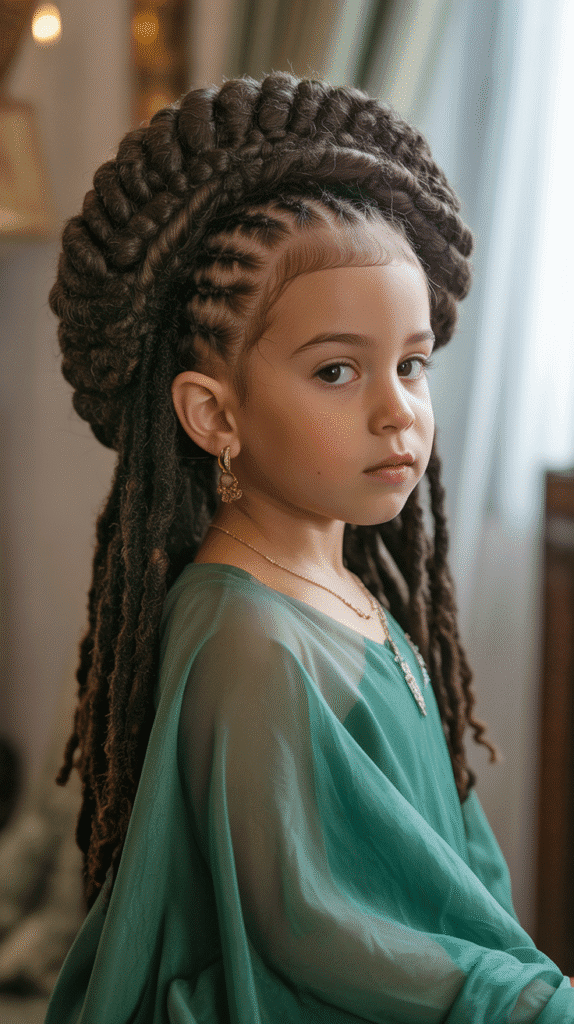
The crown braid with dreads creates a regal appearance by braiding locs around the perimeter of the head like a halo or crown.
This sophisticated style elevates simple dreadlocks into an elegant updo perfect for special occasions.
- The circular braid creates a stunning, three-dimensional effect that looks complex but is achievable.
- This style keeps all locs secured and protected, making it excellent for multi-day wear.
- Crown braids distribute tension evenly around the entire head, maximizing comfort.
- Children feel special and princess-like when wearing this beautiful, attention-getting style.
- The technique accommodates various loc lengths by adjusting the tightness and overlap.
- Adding small flowers or decorative pins throughout the crown enhances the fairy-tale aesthetic.
- This style stays intact through sleep, reducing morning preparation time on subsequent days.
13. Bubble Ponytail Dreads
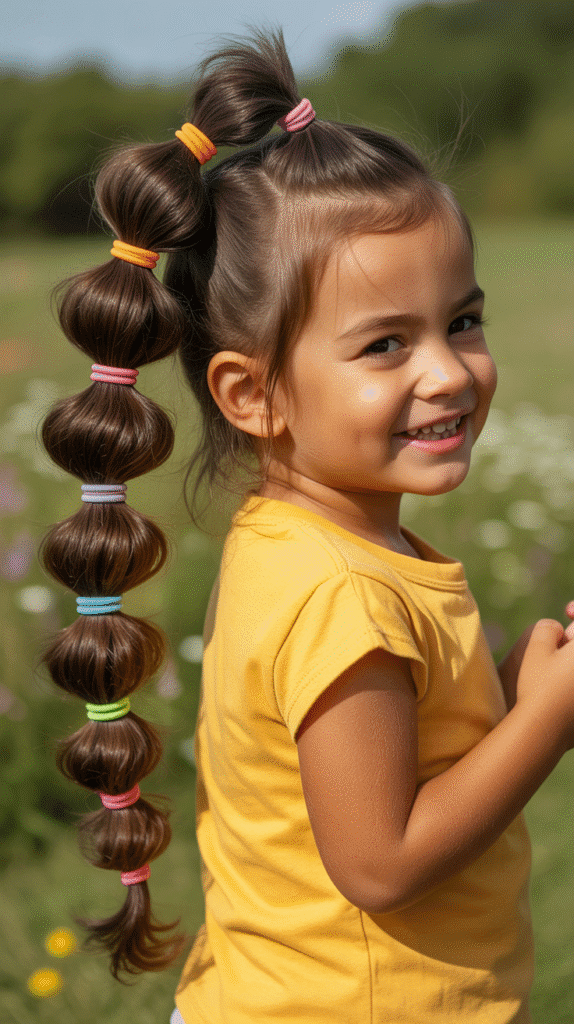
Bubble ponytail dreads create a playful segmented look by securing a ponytail at multiple intervals along its length, forming rounded “bubbles” between each tie.
This trendy style adds dimension and whimsy to otherwise simple gathered locs.
- The bubble effect creates visual interest and movement that children find fun and engaging.
- Multiple securing points actually reduce tension on the initial ponytail base, improving comfort.
- This style works with any ponytail position—high, low, or side-swept.
- Parents can adjust bubble sizes and spacing to customize the look.
- The segmented design makes longer locs feel more manageable and less heavy.
- Using colorful elastics at each bubble point creates rainbow or ombre effects.
- This trending style helps fashion-conscious kids feel current and stylish.
14. Faux Hawk Dreads
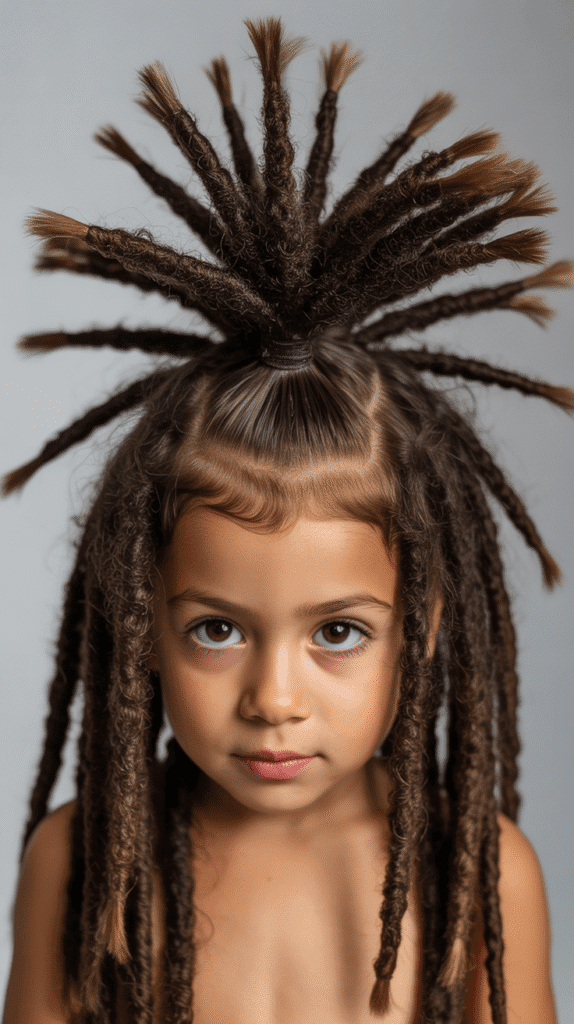
Faux hawk dreads create the illusion of a mohawk without shaving or cutting hair by styling locs upward along the center while slicking sides back or down.
This compromise style delivers edge without permanent commitment.
- The lifted center section provides bold visual impact while maintaining all hair length.
- This style allows children to experiment with edgy looks without permanent changes.
- Parents appreciate that faux hawks can be restyled into conservative looks when needed.
- The technique works with strong-hold gel or natural styling products to achieve the lift.
- Children transitioning between different style preferences find this flexibility reassuring.
- Faux hawks photograph dramatically, creating memorable images for special moments.
- The style stays secure throughout active days when properly set with appropriate products.
15. Low Bun Dreads
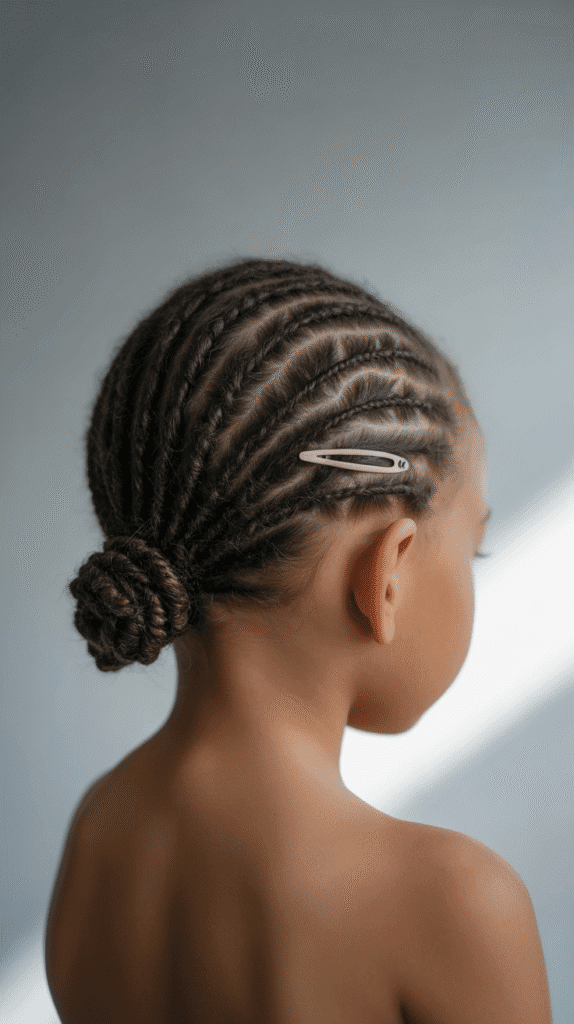
The low bun gathers dreadlocks at the nape of the neck, creating an elegant, understated style that’s simultaneously sophisticated and comfortable.
This timeless updo works beautifully for both everyday wear and formal occasions.
- The low positioning eliminates the weight pull at the crown that high buns can create.
- This style keeps hair completely secured without creating the “tight” feeling some children dislike.
- Low buns work exceptionally well for longer locs that might feel heavy in elevated styles.
- The neat appearance makes this style appropriate for school uniforms and formal dress codes.
- Children can comfortably rest their heads without bun interference during car rides or rest time.
- The low placement protects locs from excessive sun exposure during outdoor activities.
- This classic style never looks dated, ensuring children’s photos remain timeless.
16. Twisted Crown Dreads
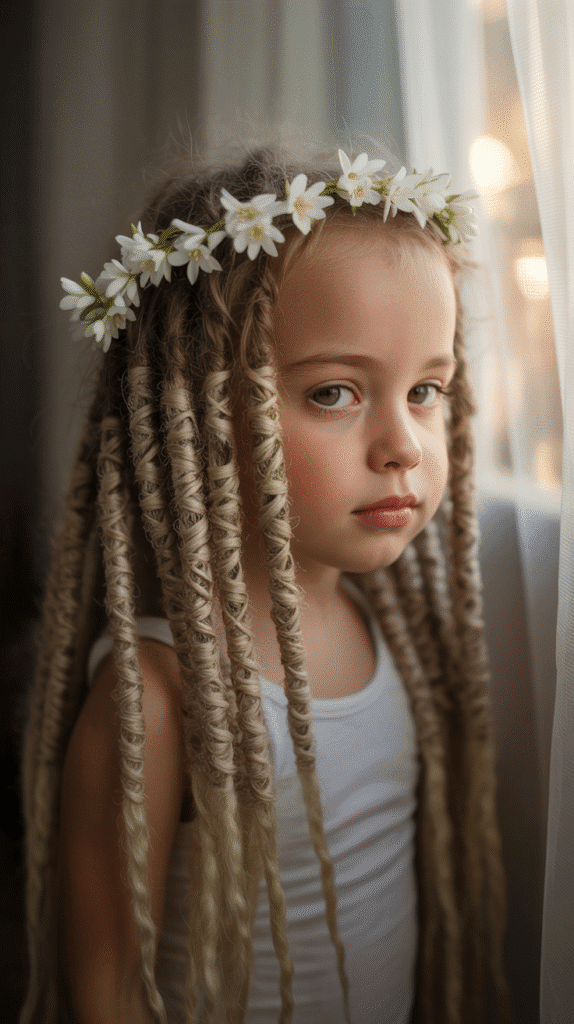
Twisted crown dreads create a textured halo effect by twisting locs along the hairline and pinning them around the head’s perimeter.
This romantic, dimensional style adds elegance while showcasing the natural beauty of dreadlocks.
- The twisted perimeter creates beautiful texture and visual depth around the face.
- This style frames facial features exquisitely, perfect for portraits and special events.
- The technique keeps front locs secured while allowing back sections to flow freely if desired.
- Children appreciate how the twisting adds “fancy” elements to their protective hairstyle.
- The crown formation distributes any tension broadly, maintaining scalp health.
- Adding small accessories like pearls or flowers throughout the twisted crown enhances elegance.
- This style works with various loc lengths by adjusting the twisting tightness and pattern.
17. Side Braid Accent
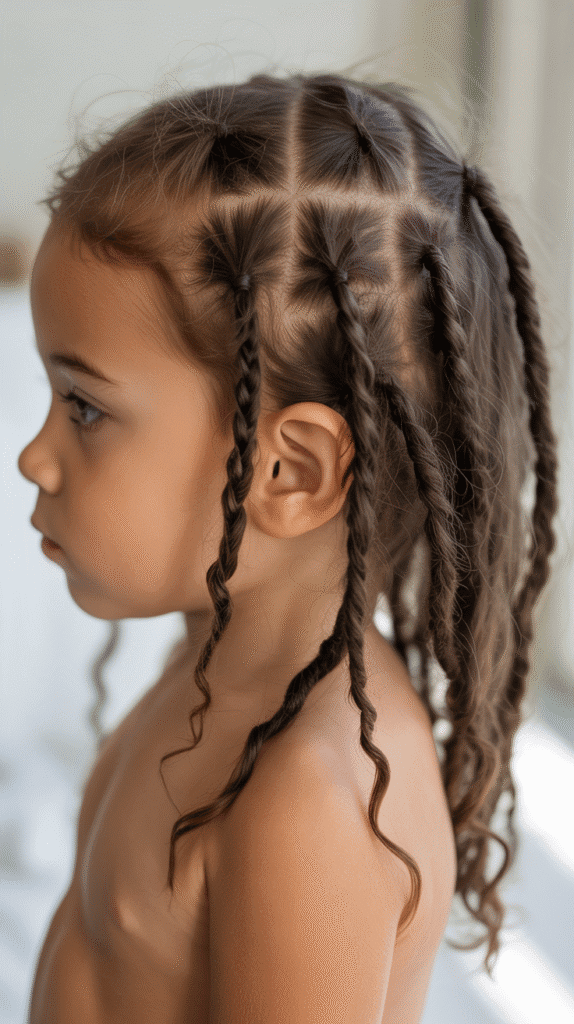
Side braid accent incorporates one or more braided sections alongside loose dreadlocks, creating contrast between the smooth braid texture and the loc texture.
This mixed-technique approach adds artistic flair to traditional dreadlock styles.
- The braided sections create visual variety that breaks up uniform loc patterns.
- This style allows children to maintain protective styling while experimenting with different textures.
- Side braids help manage face-framing locs that some children find bothersome.
- Parents can braid various quantities of locs from one to several for different effects.
- The technique teaches children about combining different styling methods creatively.
- Adding colored extensions or thread to the braided sections creates vibrant contrast.
- Side braids remain intact through multiple days, reducing daily styling time.
18. Flower Crown Dreads
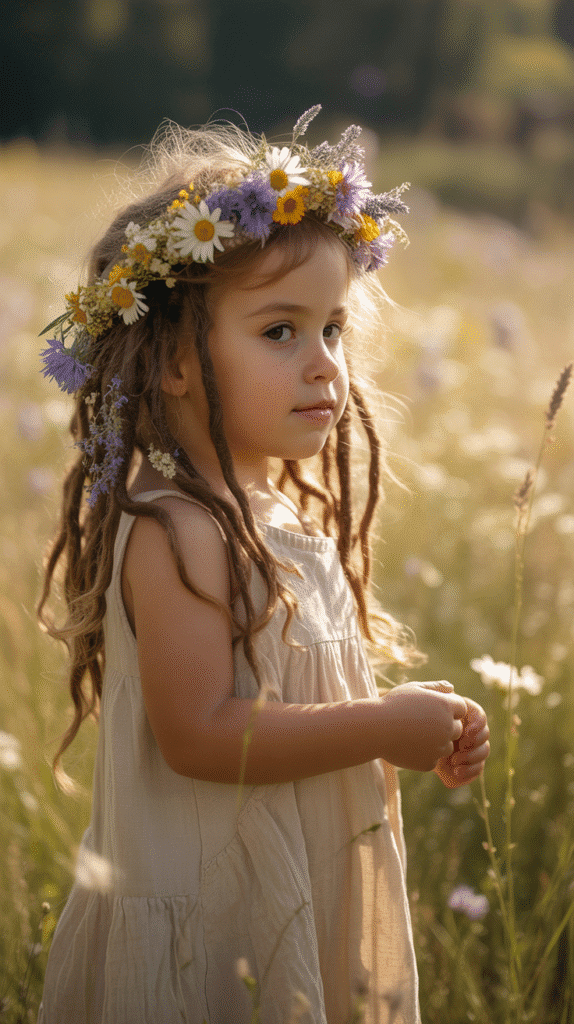
Flower crown dreads incorporate real or artificial flowers woven throughout locs or attached to an updo, creating an enchanting, nature-inspired look.
This whimsical style transforms dreadlocks into a botanical masterpiece perfect for spring and summer celebrations.
- Fresh or silk flowers add color, dimension, and fragrance to protective hairstyles.
- This style works beautifully for flower girls, birthday parties, and outdoor celebrations.
- The floral elements create memorable photographs that capture childhood magic.
- Children feel like fairy tale characters or garden sprites in this enchanting style.
- Flowers can be strategically placed to cover any less-than-perfect styling areas.
- The natural aesthetic aligns beautifully with eco-conscious family values.
- Removing flowers afterward is simple, allowing the base style to continue for days.
19. Rope Twist Ponytail
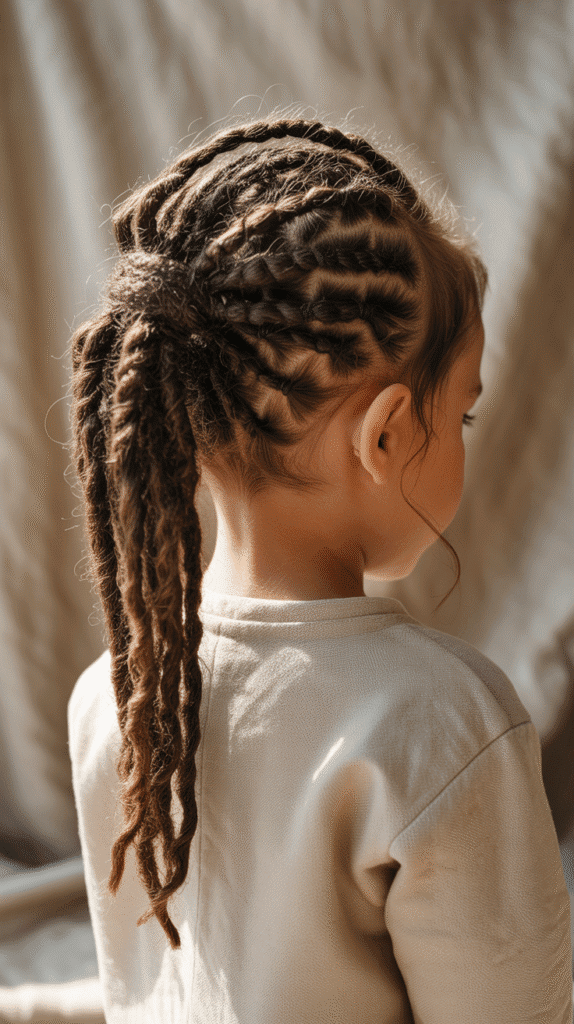
Rope twist ponytail involves twisting the gathered dreadlocks in a ponytail formation into one thick rope-like strand, creating a unified, textured look.
This technique adds sophistication and reduces the visual bulk of loose locs.
- The rope twist creates a sleek, elongated appearance that showcases loc length beautifully.
- This styling reduces tangling since individual locs are twisted together as one unit.
- The twisted formation dries faster after swimming or washing compared to loose locs.
- Children appreciate the “different” look this technique creates from standard ponytails.
- The rope effect photographs with beautiful texture and dimension in images.
- This style works with ponytails positioned at any height for versatile applications.
- Minimal accessories are needed since the twist itself creates visual interest.
20. Multiple Mini Buns
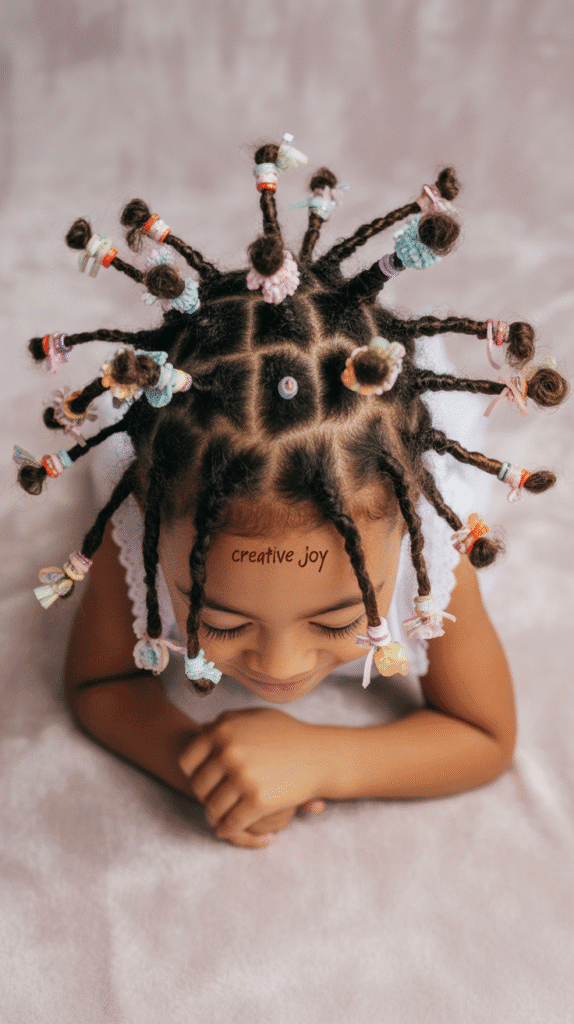
Multiple mini buns divide dreadlocks into several small sections, creating individual tiny buns scattered across the head.
This playful, creative style adds personality and keeps all hair secured while looking absolutely adorable.
- The scattered bun placement creates a unique, artistic pattern that stands out.
- Dividing locs into smaller sections reduces the weight and pull of single large buns.
- This style allows children to choose bun placement, encouraging personal expression.
- Mini buns work with various loc lengths from short to long with adjusted sizes.
- The multiple securing points actually distribute tension more evenly across the scalp.
- Each bun can be decorated differently for rainbow or theme-based effects.
- This trending style helps children feel fashionable and Instagram-worthy.
21. Waterfall Dreads
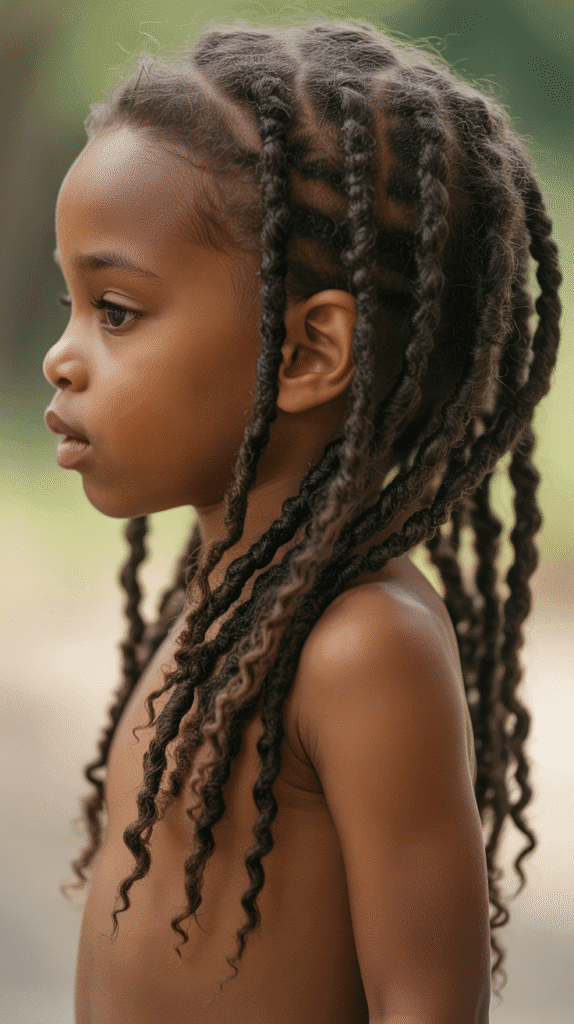
Waterfall dreads create a cascading effect by securing sections at different heights, allowing locs to flow down in graduated layers.
This dimensional style showcases length while adding visual movement and interest.
- The layered securing creates beautiful depth and dimension in photographs.
- This technique prevents all locs from falling forward simultaneously during active movement.
- The cascading effect distributes weight across multiple points for balanced comfort.
- Children enjoy the “fancy” appearance this styled approach creates.
- The waterfall pattern works with any overall style—half-up, ponytail, or side-swept.
- This method showcases highlights or color variations beautifully through the layers.
- The graduated effect makes thick, heavy locs feel more manageable and lighter.
22. Wrapped Ponytail Base
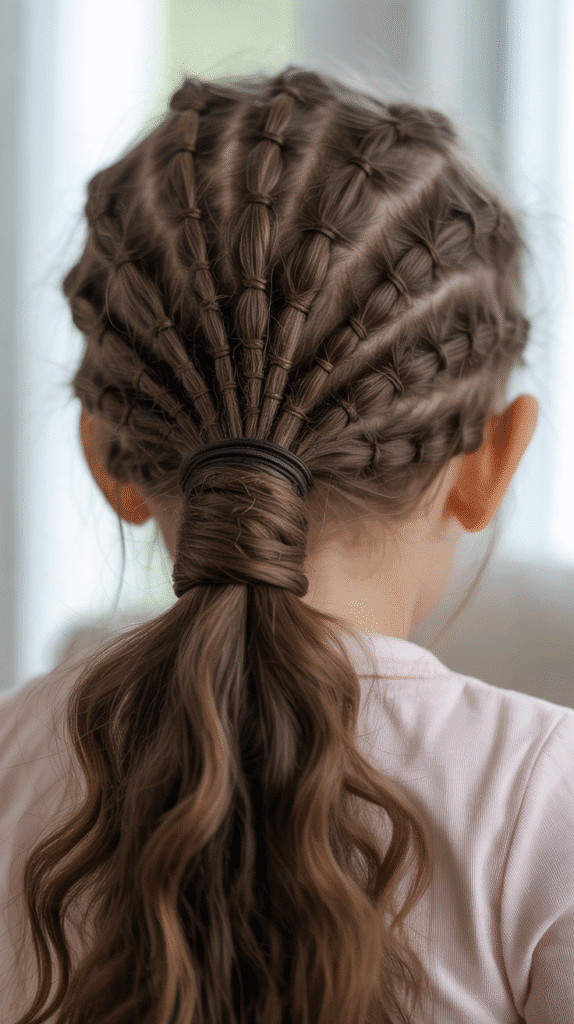
Wrapped ponytail base involves taking one or two locs and wrapping them around the elastic band securing a ponytail, concealing the hair tie.
This finishing technique elevates simple ponytails into polished, professional-looking styles.
- The wrapped loc conceals plastic or fabric elastics for a more refined appearance.
- This technique takes just seconds but dramatically improves the overall style aesthetic.
- Children learn that small finishing touches make significant visual differences.
- The wrapped section prevents elastics from snagging or pulling on locs.
- This method works with ponytails at any position or height for universal application.
- The polished look makes casual styles appropriate for more formal settings.
- No additional accessories are needed since locs themselves create the decorative element.
23. Asymmetrical Part Dreads
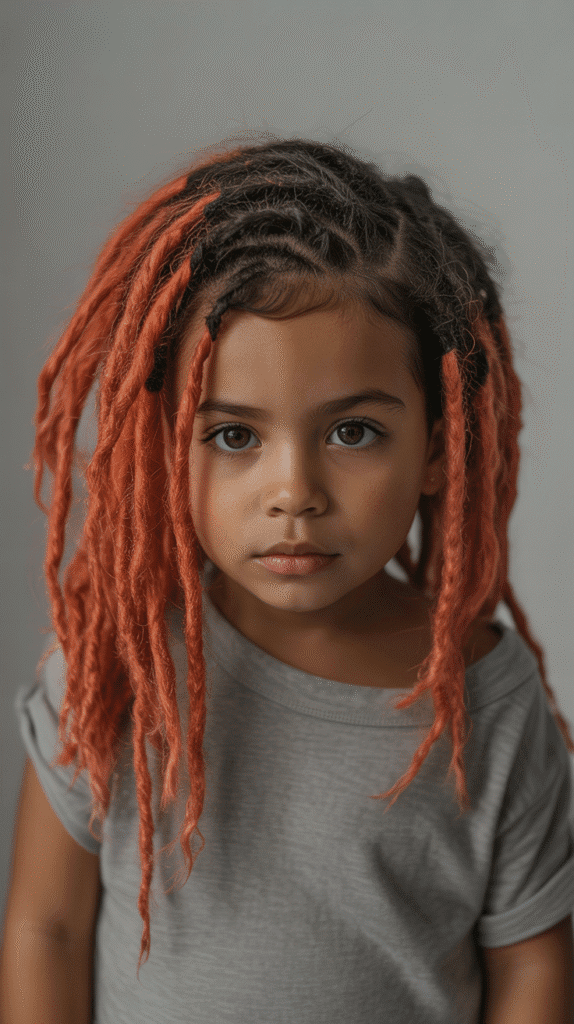
Asymmetrical part dreads replace centered parts with off-center divisions, creating dynamic, modern looks with built-in visual interest.
This simple adjustment transforms traditional styles into contemporary statements.
- The off-center placement creates immediate visual interest without additional styling.
- Asymmetrical parts add edge and fashion-forward sensibility to classic looks.
- This technique helps camouflage any unevenness in loc distribution or density.
- Children enjoy the “different” appearance compared to peers with traditional center parts.
- The angled division creates natural volume on one side for enhanced dimension.
- Asymmetrical parts photograph with more dynamic composition in images.
- This modern approach keeps styles looking current and intentional.
24. Beaded Dreads
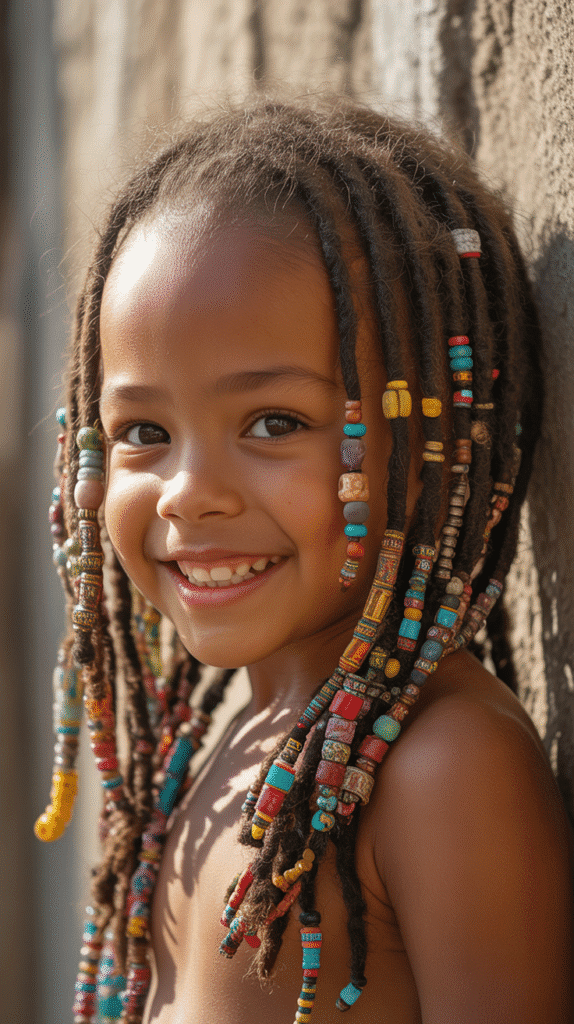
Beaded dreads incorporate decorative beads threaded onto individual locs at various positions, adding color, personality, and cultural significance.
This traditional decoration method personalizes dreadlocks while celebrating African hair heritage.
- Beads add weight that can help locs hang straighter and more defined.
- The clicking sound beads make during movement delights many children.
- Different bead colors, materials, and patterns allow endless customization options.
- This decoration method celebrates cultural traditions and Black hair history beautifully.
- Beads can be positioned strategically to hide any less mature or thin areas.
- The accessories are easily removable and changeable based on mood or occasion.
- Wooden, metal, or plastic beads each create different aesthetic and audio effects.
25. Criss-Cross Base Ponytail
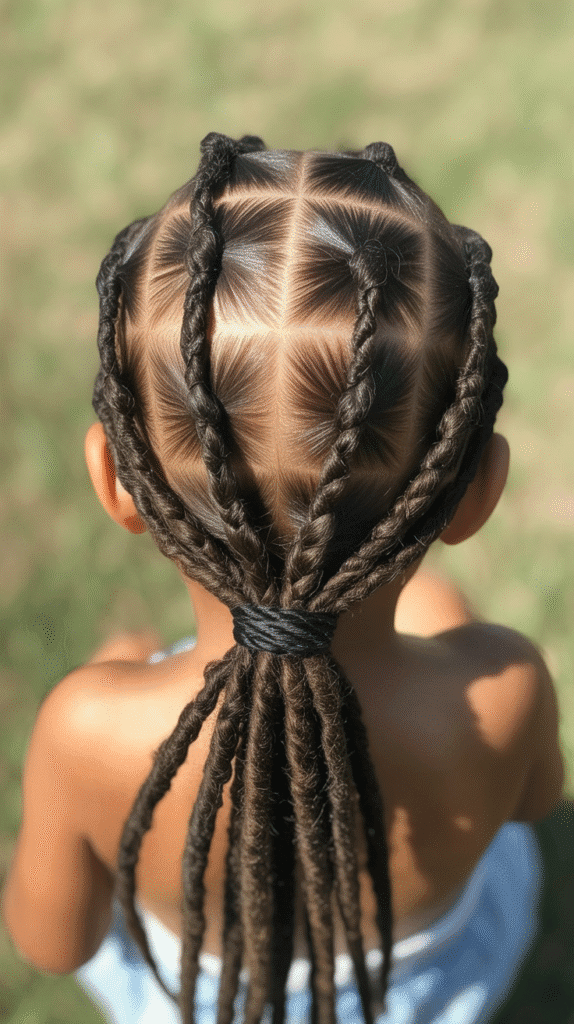
Criss-cross base ponytail creates an X-pattern at the ponytail foundation using locs before gathering all hair together.
This decorative technique adds geometric interest to the style’s foundation.
- The X-pattern creates immediate visual appeal at the style’s focal point.
- This technique helps secure ponytails more firmly, reducing slippage during activities.
- Children enjoy the “special” detailing that makes standard ponytails more interesting.
- The criss-cross can be created with natural locs or added synthetic hair for contrast.
- This method works with any ponytail position from low to high placements.
- The geometric pattern photographs beautifully, creating memorable style documentation.
- Parents can teach children to create this pattern, building independence.
26. Side Part with Accessories
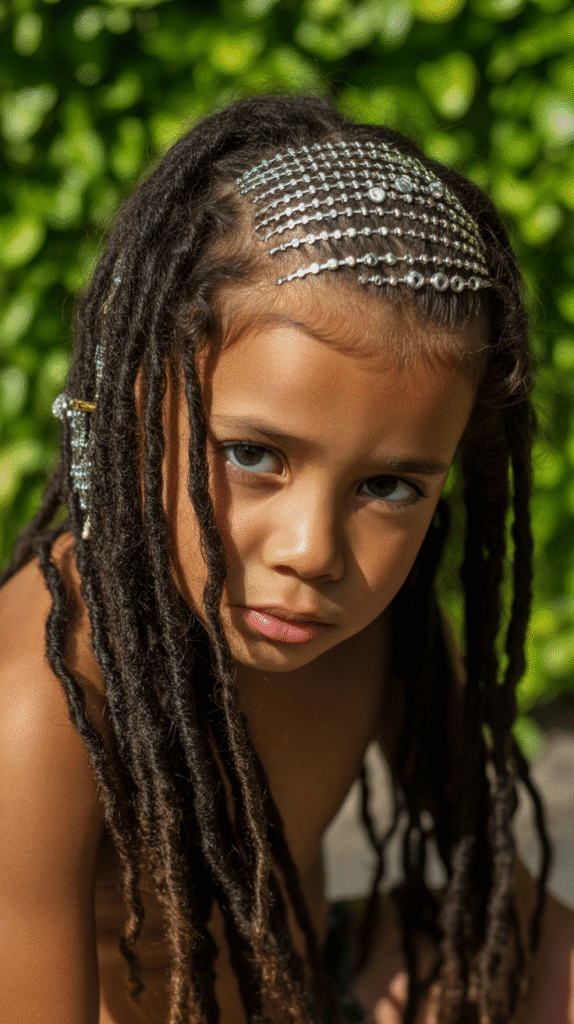
Side part with accessories combines a dramatic side part with decorative elements like clips, pins, or jeweled accessories positioned along the part line.
This style merges simplicity with embellishment for easy elegance.
- The deep side part creates instant asymmetry and visual interest.
- Accessories along the part line draw attention and add sparkle or color.
- This approach allows children to express personality through accessory choices.
- The combination works with loose locs or can precede any subsequent updo.
- Strategic accessory placement can disguise any part imperfections or sparse areas.
- This style transitions easily from school to special events by changing accessories.
- Minimal time investment creates maximum visual impact for efficient styling.
27. Barrel Roll Dreads
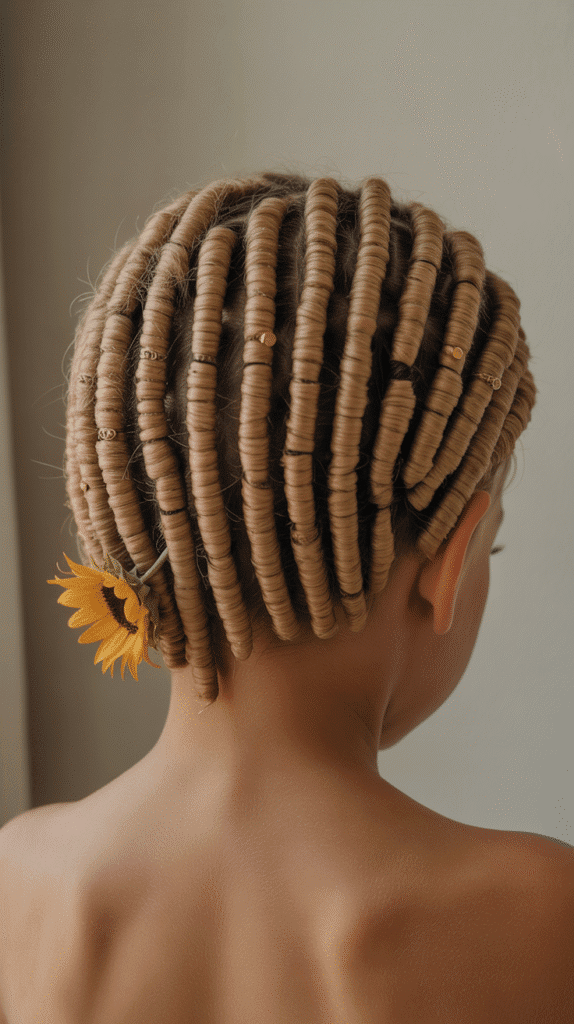
Barrel roll dreads involve rolling locs into a horizontal cylinder shape at the back of the head, creating a unique alternative to traditional buns.
This structured style offers geometric appeal with secure hold.
- The horizontal roll creates a distinctive silhouette different from round buns.
- This technique works exceptionally well with medium to long length locs.
- The barrel shape distributes weight horizontally, reducing vertical pull.
- Children appreciate the “different” appearance this less common style creates.
- The structured formation stays secure throughout vigorous activities and play.
- This style keeps all hair neatly contained for school and formal requirements.
- The horizontal orientation allows comfortable head positioning during rest or sleep.
28. Triple Ponytail Cascade
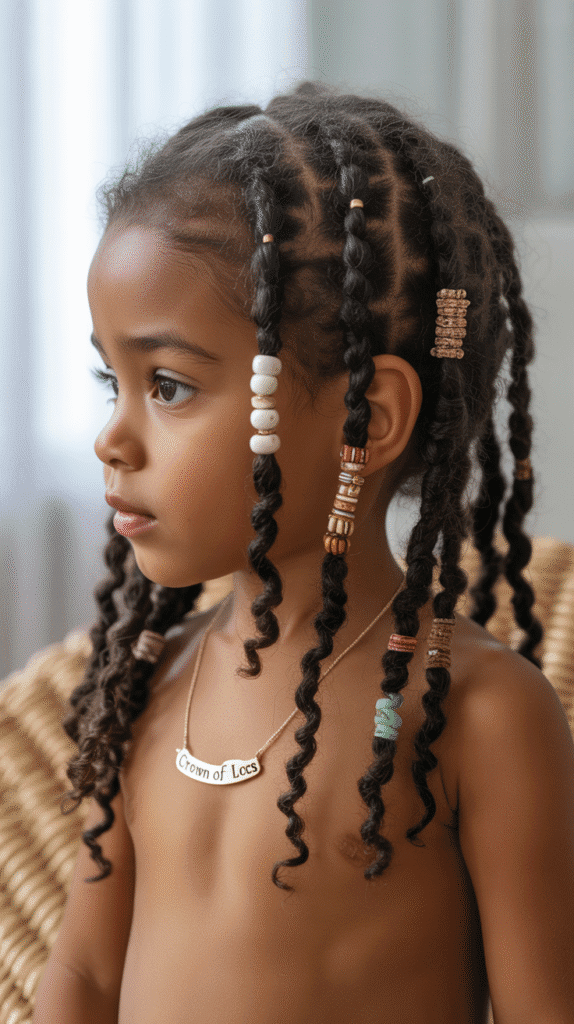
Triple ponytail cascade creates three ponytails positioned vertically down the head, with each subsequent ponytail incorporating locs from the one above.
This graduated style adds complexity and visual flow.
- The cascading formation creates beautiful movement and dimension as child moves.
- This technique makes very long locs more manageable by sectioning them.
- Each ponytail level can feature different accessories for coordinated variety.
- The vertical progression creates an elongated, elegant silhouette.
- Children enjoy the layered effect that photographs beautifully from all angles.
- The multiple securing points distribute weight, improving all-day comfort.
- This trending style stands out at school, making children feel fashionable.
29. Twisted Side Bu
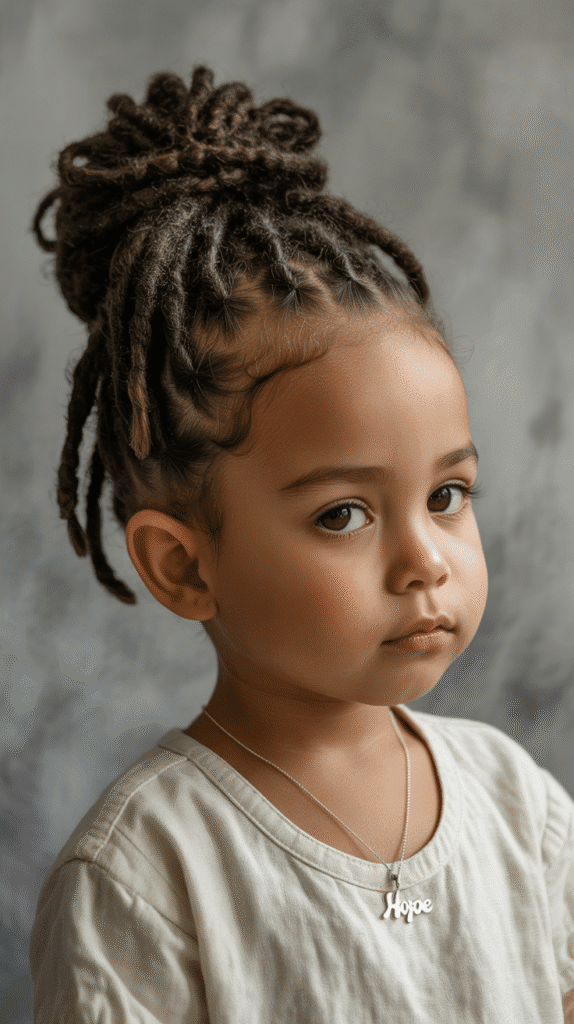
Twisted side bun combines twisting techniques with bun formation, positioning the finished style to one side of the head.
This elegant asymmetrical updo balances sophistication with youthful charm.
- The side positioning creates natural asymmetry that’s visually interesting.
- Twisting locs before bunning adds texture and dimension to the finished style.
- This placement allows comfortable side-sleeping without bun interference.
- The style works beautifully for formal events while remaining comfortable for children.
- Side buns showcase earrings and facial features from certain angles beautifully.
- The twisted texture prevents the bun from looking too severe or tight.
- This style stays secure through dancing, running, and active celebrations.
30. Loc Mohawk with Curled Ends
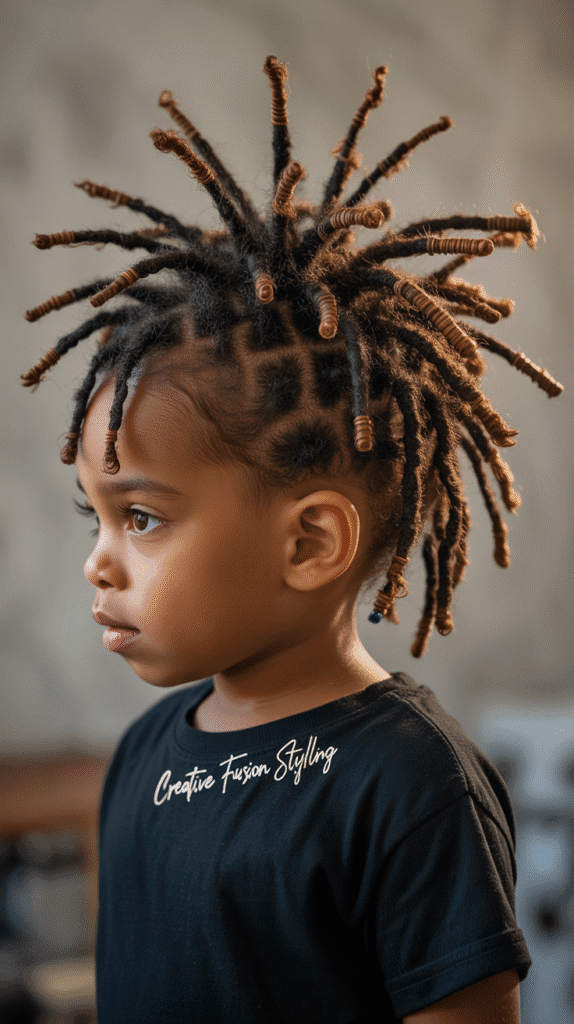
Loc mohawk with curled ends elevates the traditional mohawk by adding curl to the tips of the elevated center locs.
This fusion style combines edge with softness for a unique balanced aesthetic.
- The curled ends soften the traditionally bold mohawk appearance.
- This technique works by using perm rods or flexi-rods on loc ends.
- The contrast between straight locs and curled tips creates visual interest.
- Children enjoy the dimensional, textured appearance the curls provide.
- The style allows experimentation with different curl sizes for varied effects.
- Curled tips add movement and bounce that makes the style feel playful.
- This fusion approach demonstrates that protective styles can be customized creatively.
31. Low Pigtails with Wrapped Bases
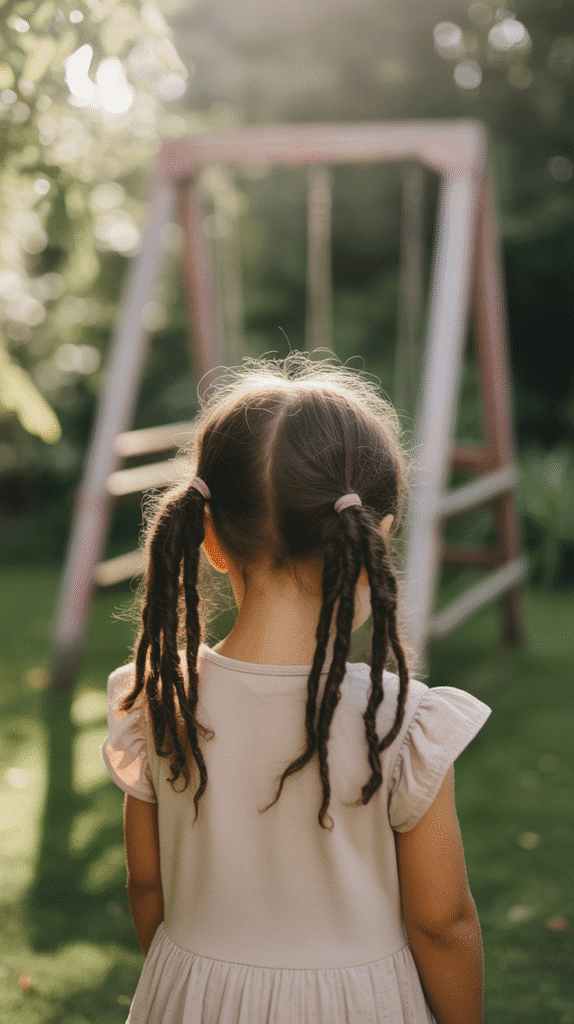
Low pigtails with wrapped bases position pigtails at the nape level and use the wrapping technique on each elastic foundation.
This polished variation on classic pigtails adds refinement to a youthful favorite.
- The low positioning creates a more sophisticated take on traditional high pigtails.
- Wrapped bases add that finishing touch that elevates the overall appearance.
- This style works beautifully under winter hats without creating uncomfortable bulk.
- Children can transition from active play to formal settings without restyling.
- The lower placement puts less tension on the scalp compared to high pigtails.
- This refined version works well for school uniforms and dress code requirements.
- The combination of classic structure and polished detail creates timeless appeal.
32. Heart-Shaped Part
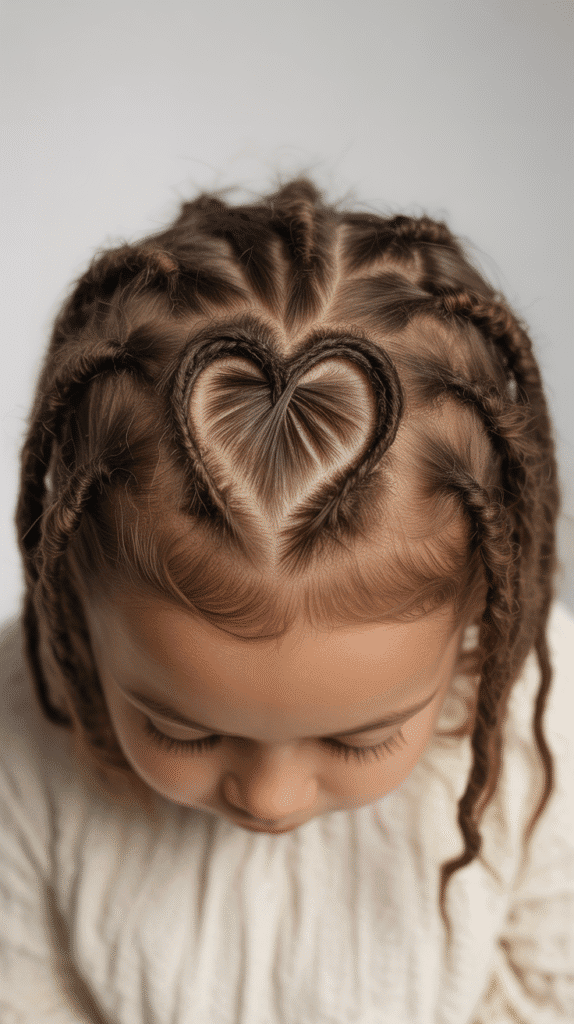
Heart-shaped part creates a heart outline at the crown or front of the head using strategic parting techniques.
This adorable detail adds romance and whimsy to any subsequent dreadlock style.
- The heart shape creates an instantly recognizable and photograph-worthy detail.
- This creative parting works as a base for ponytails, buns, or loose styles.
- Children feel special and loved with this sweet symbolic shape.
- The technique works on various hair densities with adjustment to heart size.
- Heart parts are perfect for Valentine’s Day, birthdays, or any celebration of love.
- This styling demonstrates that protective hairstyles can incorporate playful artistry.
- The symbolic shape creates meaningful documentation for childhood photo albums.
33. Wrapped Ponytail Length
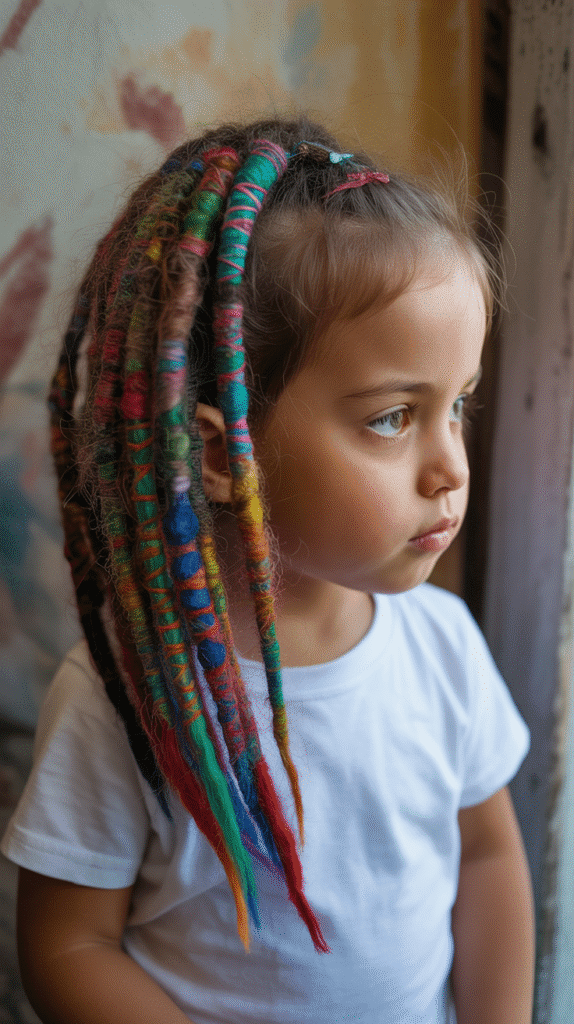
This decorative technique adds color and dimension while protecting the ponytail from environmental damage.
- The wrapping creates a smooth, polished appearance that conceals individual loc texture.
- Colorful wrapping materials allow children to express personality through color choices.
- This technique actually protects locs from friction, sun damage, and excessive handling.
- The wrapped column creates dramatic length emphasis perfect for special occasions.
- Children can choose wrapping colors to match outfits, seasons, or favorite themes.
- The technique teaches patience and fine motor skills when children participate in creation.
- Wrapped ponytails photograph with beautiful texture and vibrant color impact.
34. Bantu Knot-Out Dreads
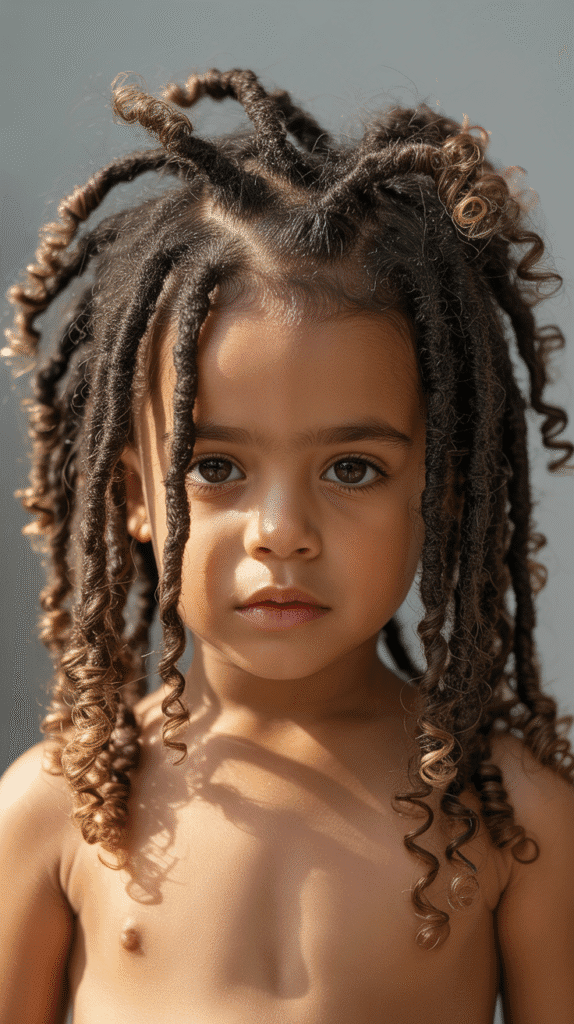
Bantu knot-out dreads involve creating small twisted knots throughout the locs, leaving them set overnight, then unraveling to reveal beautiful curl patterns.
This technique adds texture variation and volume to dreadlocks.
- The knot-out process creates defined curls at loc ends without heat damage.
- This method adds significant volume and fullness to thinner or maturing locs.
- Children love the transformation from knots to flowing curls as a fun reveal.
- The curl pattern lasts several days, making it efficient for busy schedules.
- This technique works on all loc lengths, with adjustments to knot size.
- Bantu knots can be worn as a style themselves before unraveling for versatility.
- The cultural styling method connects children to African hair traditions beautifully.
35. Crown with Loose Cascade
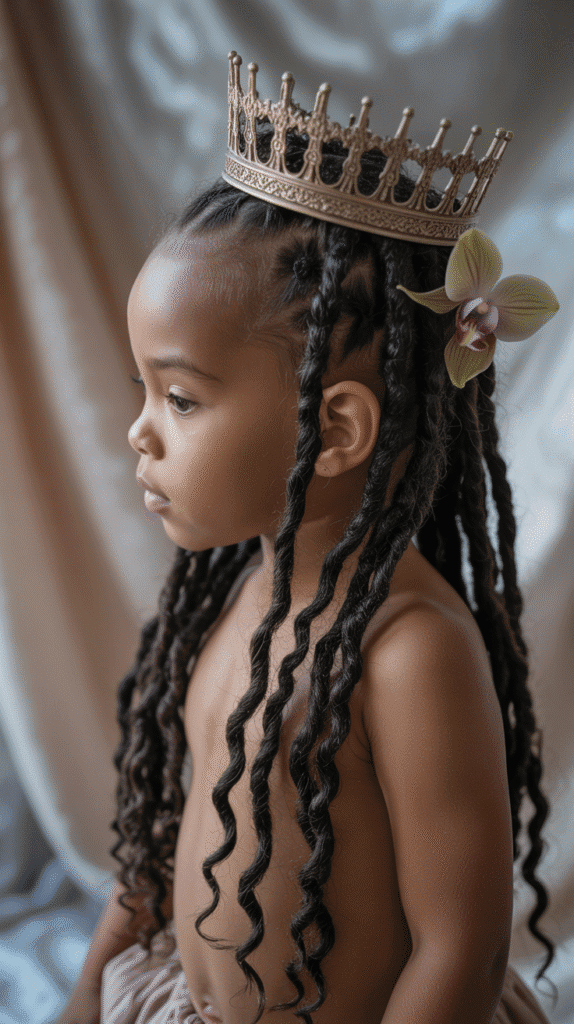
Crown with loose cascade secures locs around the hairline in an updo formation while allowing the remaining length to flow freely down the back.
This combination style merges elegance with natural movement.
- The secured crown keeps hair away from the face for functionality.
- Loose flowing locs provide the movement and drama children enjoy.
- This style balances the benefits of updos with the appeal of wearing hair down.
- The crown section can be styled in various ways—braided, twisted, or pinned.
- Children transitioning from always-down to updo styles find this compromise comfortable.
- The flowing cascade showcases loc length and health beautifully.
- This versatile style works for casual days and formal events equally well.
36. Accessories-Filled Locs
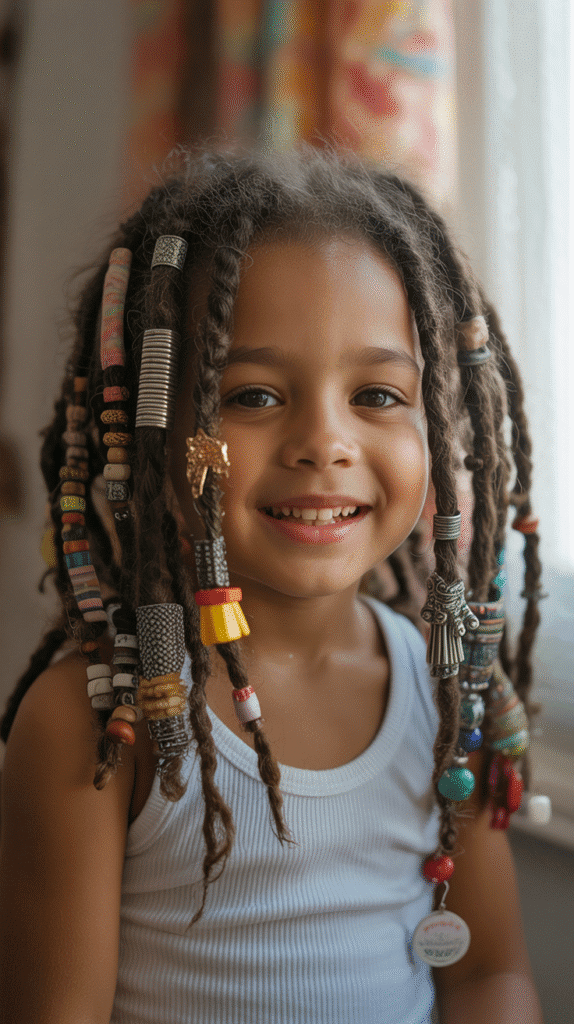
Accessories-filled locs incorporate multiple decorative elements throughout the dreadlocks—beads, cuffs, wraps, and charms—creating a personalized, expressive style.
This maximalist approach celebrates individuality and creativity.
- Multiple accessories create visual interest at various points throughout the locs.
- Children can curate their accessory collection to reflect interests and personality.
- The varied decorations create beautiful sound and movement during activities.
- This approach allows easy style updates by simply changing or adding accessories.
- Different accessory types—metal, wood, fabric, glass—create varied aesthetics.
- The personalized decoration makes each child’s locs uniquely their own.
- Accessories can mark special occasions, trips, or meaningful moments as keepsakes.
37. Simple Middle Part with Loose Locs
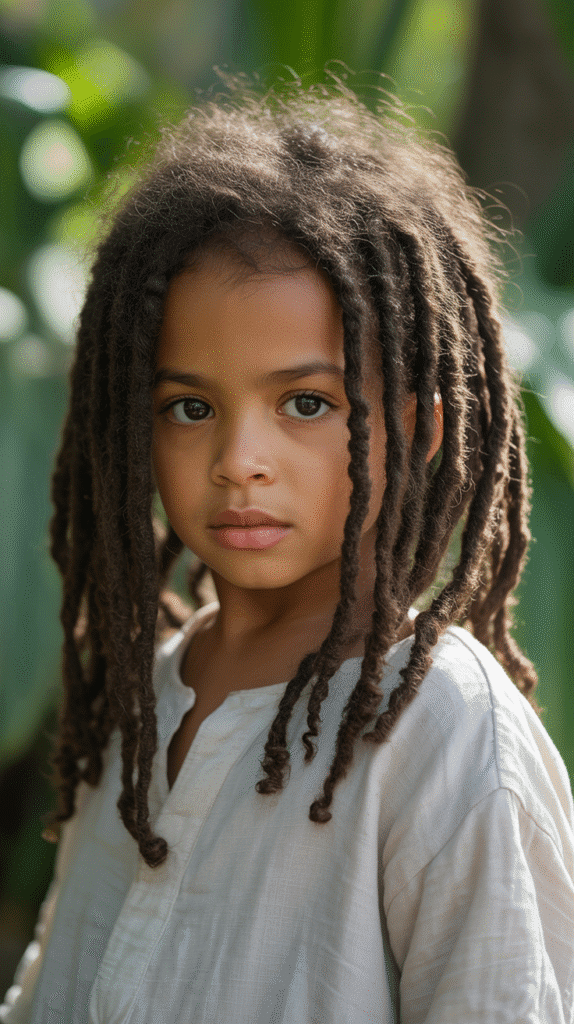
Simple middle part with loose locs embraces minimalism by creating a clean center part and allowing dreadlocks to hang naturally without additional styling.
This effortless look celebrates the natural beauty of locs themselves.
- The simple approach requires minimal daily maintenance for busy families.
- Loose locs allow maximum air circulation to the scalp for comfort.
- This natural styling lets loc texture and formation shine as the focal point.
- Children appreciate the freedom and comfort of unstyled, flowing hair.
- The middle part creates symmetry and balance that’s universally flattering.
- This low-manipulation style promotes loc health and maturation.
- The classic simplicity ensures the style never looks dated in photographs.
Maintenance Tips for Kids’ Dreadlocks
Proper maintenance ensures that dreadlocks remain healthy, beautiful, and comfortable for children throughout their loc journey. Understanding essential care practices helps parents preserve both hair health and style integrity.
- Use lightweight oils like jojoba or grapeseed to moisturize without causing buildup.
- Choose residue-free shampoos specifically formulated for locs to prevent product accumulation.
- Keep retwisting sessions gentle to avoid excessive tension on developing follicles.
- Protect locs during sleep with satin or silk bonnets to reduce friction and frizz.
- Trim any excessive lint or debris caught in locs to maintain clean appearance.
- Monitor for any scalp irritation, redness, or discomfort that might indicate styling is too tight.
- Encourage children to avoid excessive loc manipulation and twisting throughout the day.
- Ensure locs dry completely after washing to prevent mildew and unpleasant odors.
Learn more about proper loc care through resources at NaturallyCurly and The Loc Method.
Age-Appropriate Styling Considerations
Different ages require different approaches to dreadlock styling, balancing aesthetics with developmental appropriateness and comfort. Understanding age-specific needs helps parents choose styles that work best for their child’s stage.
- Toddlers (2-4 years): Prioritize comfort and simplicity with shorter locs and minimal manipulation.
- Young children (5-7 years): Focus on styles that stay secure during active play and require minimal morning preparation.
- Pre-teens (8-12 years): Allow more input in style choices to build confidence and personal expression.
- Teenagers (13+): Support experimentation with trendy styles while maintaining hair health.
- Consider attention span when choosing styles—younger children need quicker styling sessions.
- Evaluate activity levels when selecting styles, ensuring hair won’t interfere with sports or play.
- Assess your child’s sensitivity to scalp tension and adjust styling tightness accordingly.
- Factor in school dress codes and requirements when planning regular rotation styles.
- Introduce gradually increasing styling complexity as children develop patience and interest.
Choosing the Right Style for Your Child
Selecting appropriate dreadlock styles involves considering multiple factors beyond just aesthetics. The right choice balances beauty, practicality, comfort, and your child’s unique personality and needs.
- Hair length: Shorter locs limit updo options but offer easier maintenance and faster drying.
- Hair thickness: Denser locs support more elaborate styles, while thinner locs work better with simpler arrangements.
- Activity level: Highly active children benefit from secure styles that won’t require constant adjustment.
- Occasion: Daily school styles differ from special event styles in complexity and formality.
- Child’s preference: Involving children in style decisions builds confidence and enthusiasm.
- Parent’s skill level: Be realistic about your styling abilities and available time.
- Weather conditions: Hot climates favor updos while cooler weather accommodates loose styles comfortably.
- Sleep habits: Consider how styles will hold up through sleep or whether daily restyling is feasible.
- Test new styles on low-pressure days before implementing them for important events.
- Take photos of successful styles from multiple angles for future recreation reference.
Product Recommendations for Kids’ Locs
Using appropriate products specifically formulated for children’s hair and dreadlocks ensures health, manageability, and beautiful results. Quality products prevent buildup while providing necessary moisture and hold.
- Residue-free shampoo: Prevents product buildup that can cause matting and odor in locs.
- Lightweight moisturizing oils: Jojoba, argan, or grapeseed oils hydrate without heavy residue.
- Natural hold gels: Aloe vera or flaxseed gels provide styling hold without harmful chemicals.
- Satin or silk hair accessories: Reduce friction and breakage compared to cotton or elastic materials.
- Spray bottles: Make daily moisturizing routines quick and easy for busy mornings.
- Loc-specific conditioners: Provide moisture without causing slippage or loc unraveling.
- Avoid heavy butters and creams that can accumulate inside locs over time.
- Choose products with minimal ingredients to reduce buildup and allergic reaction risks.
- Test new products on a small section before applying throughout all locs.
- Read labels carefully to avoid sulfates, parabens, and mineral oils in children’s hair products.
Find quality loc-specific products at retailers like Target, Sally Beauty, and Ulta Beauty.
Common Styling Mistakes to Avoid
Understanding common pitfalls in children’s dreadlock styling helps parents protect hair health while maintaining beautiful appearances. Avoiding these mistakes ensures positive loc experiences for both parents and children.
- Over-tightening styles: Creates unnecessary tension that can damage follicles and cause traction alopecia.
- Excessive manipulation: Constant touching, twisting, and restyling weakens locs and prevents proper maturation.
- Using wrong products: Heavy creams, waxes, and petroleum-based products cause buildup inside locs.
- Neglecting scalp health: Focusing only on locs while ignoring scalp leads to dryness, irritation, and discomfort.
- Infrequent washing: Believing locs shouldn’t be washed regularly leads to hygiene issues and buildup.
- Ignoring child’s discomfort: Pushing through pain or tightness can create negative associations with hair care.
- Comparing maturation rates: Every child’s locs develop differently; avoid comparing to others’ timelines.
- Skipping protective sleep practices: Cotton pillowcases cause friction, frizz, and moisture loss overnight.
- Listen to your child’s feedback about comfort and adjust techniques accordingly.
- Remember that beautiful locs start with healthy scalp and hair foundations.
Cultural Significance and Education
Dreadlocks carry deep cultural meaning and historical significance, particularly within African and African diaspora communities. Educating children about this heritage builds pride and understanding.
- Dreadlocks have ancient roots in various cultures including Ethiopian, Rastafarian, and Hindu traditions.
- The style represents spiritual devotion, cultural identity, and resistance to oppressive beauty standards.
- Teaching children about loc history creates appreciation for their hairstyle’s significance.
- Dreadlocks challenge Eurocentric beauty norms and celebrate natural Black hair textures.
- The style has faced discrimination in schools and workplaces, making education about rights important.
- Understanding cultural context helps children respond confidently to questions or comments about their hair.
- Connecting with community through loc journey creates supportive networks and shared experiences.
- Books, documentaries, and cultural events provide age-appropriate education about loc significance.
Explore cultural hair history through resources at Black Hair Care and cultural education platforms.
Dealing with School and Social Situations
Children with dreadlocks may encounter questions, comments, or even challenges in school and social settings. Preparing them with confidence and information creates positive experiences.
- Teach children age-appropriate responses to common questions about their hair.
- Role-play scenarios where peers might ask to touch or make comments about locs.
- Know your child’s rights regarding hairstyle discrimination under laws like the CROWN Act.
- Communicate proactively with teachers and administrators about your child’s hairstyle.
- Build confidence by emphasizing the beauty and significance of their natural hair.
- Connect with other loc-wearing families for community support and shared experiences.
- Address any negative comments or discrimination immediately through proper channels.
- Celebrate your child’s unique appearance and encourage pride in their individuality.
- Document your child’s loc journey with photos to create positive memories and tracking.
- Remind children that their hair is beautiful regardless of others’ opinions or reactions.
Transitioning Between Styles
Successfully moving between different dreadlock styles requires planning, patience, and proper technique. Smooth transitions maintain hair health while keeping styling fresh and interesting.
- Allow scalp rest periods between particularly tight or tension-heavy styles.
- Moisturize thoroughly before attempting new styles to improve manageability.
- Start with clean, freshly washed locs when creating elaborate styles for best results.
- Remove old styles gently, taking time to avoid unnecessary pulling or breakage.
- Consider your child’s schedule when planning transition timing to avoid rushed mornings.
- Take photos of favorite styles from multiple angles for future recreation.
- Experiment with new styles on low-pressure days before important events.
- Listen to your child’s preferences and comfort levels when introducing new looks.
- Gradually increase styling complexity rather than jumping to advanced techniques immediately.
- Remember that some styles work better at certain loc maturity stages than others.
Long-Term Loc Care and Health
Maintaining healthy dreadlocks throughout childhood requires commitment to consistent care practices and attention to changing needs. Long-term success comes from establishing good habits early.
- Regular professional maintenance appointments every 2-3 months support proper loc development.
- Adjust care routines as locs mature from starter phase through established locks.
- Monitor for thinning, breakage, or weak spots that may need special attention.
- Increase protective styling during growth spurts when hair may be more vulnerable.
- Document loc journey with periodic photos to track progress and identify any concerns.
- Maintain open communication with your child about comfort, preferences, and any issues.
- Invest in quality tools like seamless hair ties and metal-free accessories to prevent damage.
- Create a sustainable routine that fits your family’s schedule and lifestyle realistically.
- Celebrate milestones like loc anniversaries to maintain enthusiasm and positive associations.
- Stay informed about evolving best practices and new products through natural hair communities.
Connect with loc professionals and communities at LocNation and natural hair forums.
Conclusion
Throughout this comprehensive guide to 37 Adorable Dreadlock Styles for Kids That Are Easy & Cute, we’ve explored a beautiful spectrum of protective styling options that celebrate natural hair while prioritizing practicality and child-friendly application.
From classic approaches like simple middle parts and low buns to creative expressions like flower crowns and accessories-filled locs, these styles demonstrate that protective hairstyling can be both functional and absolutely adorable.
The key to success lies in understanding your child’s unique hair texture, activity level, and personal preferences while maintaining consistent care practices that promote scalp health and loc maturation.
By incorporating age-appropriate styling choices, quality products, and proper maintenance techniques, you’re not just creating beautiful hairstyles—you’re building your child’s confidence, celebrating cultural heritage, and establishing positive relationships with natural hair care.
Remember that every loc journey is unique, with its own timeline and characteristics, so embrace the process with patience and flexibility.
Whether you’re just beginning your child’s dreadlock journey or seeking fresh inspiration for established locs, these 37 styles offer endless possibilities for expressing creativity while protecting and nurturing your child’s beautiful natural hair.
Most importantly, involve your child in the styling process, listen to their comfort levels, and celebrate the joy that comes from embracing their natural texture with pride and love.Retry
